Exploring The Best Larch Hikes in Kananaskis And Beyond
Welcome to the golden season of larch hikes in Kananaskis! As autumn paints the landscape, the majestic larch trees steal the show with their breathtaking display of golden foliage. In this guide, we’ll delve into what makes larch hikes in Kananaskis so special, where to find these magnificent trees, and how to make the most of your experience.
Disclaimer: This post may include affiliate links. If you click one of them, I may receive a small commission at no extra cost to you.
What are Larch Trees?
Larch trees stand out among conifers for their deciduous nature. Unlike most conifers that retain their needles year-round, larch trees shed their soft, needle-like leaves in the fall. These needles are arranged in clusters along the branches and typically spiral around them. If you ever touch these needles in their prime, they are super soft as compared to needles of other fir trees.
Larch trees are found in cooler regions of the northern hemisphere, and thrive in mountainous areas of Europe, Asia, and North America. They can withstand harsh winters and short growing seasons, making them well-suited to cold climates.
Larch trees provide habitat and food for numerous wildlife species and contribute to soil stabilization and nutrient cycling. Moreover, in regions where they are native, larch trees hold cultural significance. For instance, in Siberia, they are revered as sacred trees associated with traditional beliefs and rituals.
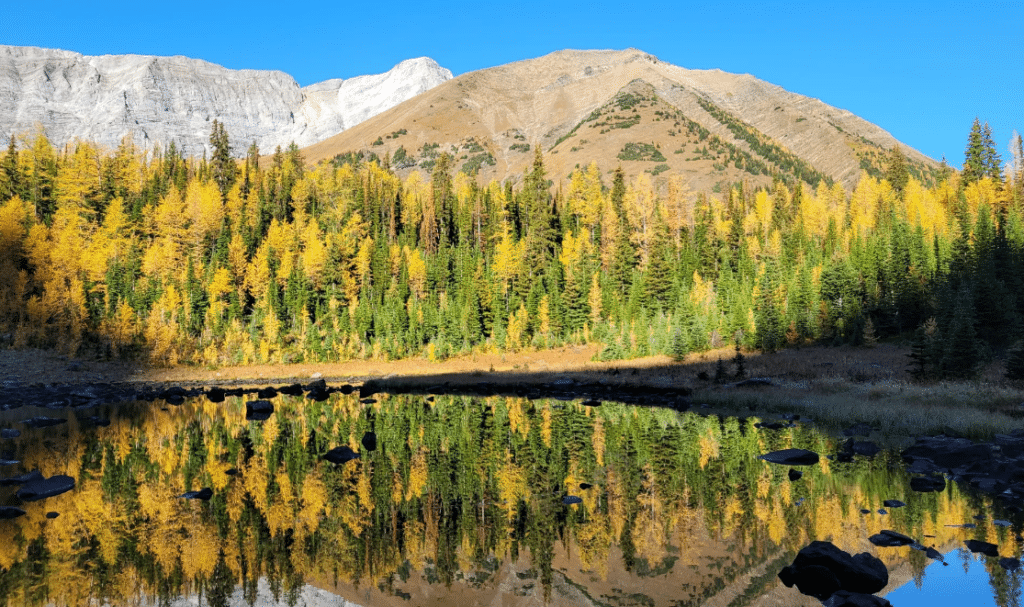
When Is The Best Time to See Larches At Their Prime?
There is a short window of time to see the larch trees when they turn their golden color and look spectacular. I find the best time is usually around the third week of September and your period of time to see them is usually around a week. This of course is not set in stone and is dependent on the weather and its trends. Plan accordingly!
Many of these hikes are a bit more difficult, due to the higher elevations. However, if you want to learn to hike, some of these hikes are totally doable, as long as you take your time and are prepared.
Best Places to Find Larch Trees
In the Canadian Rockies, the best locations to see larch trees is along Highway 40, specifically from Highwood Pass north to Highway 742 (Smith-Dorrien Highway). These areas offer stunning vistas and excellent hiking opportunities amidst the golden larches. It really is my favorite time of year to hike; as is it everyone else’s. It is a sight to see!
TIP: Hiking off of Highway 40 requires the purchase of a Kananaskis Conservation Pass in order to do these hikes. Please ensure you buy one in advance.
Best Larch Hikes in Kananaskis
Highwood Pass is the highest paved mountain roadway in Canada, reaching an elevation of 2,206 metres. For comparison’s sake, Calgary is at an elevation of 1,045 metres. If you are not into hiking and just want to see the trees, you can come to this parking spot and enjoy the views while you drive Highway 40. The parking and people in this area will be unbelievable during this peak time so I suggest you either go super early or later in the afternoon to make sure you get a parking spot.
Pocaterra Cirque
| Location | Distance: 7.0 kms (4.35 miles) | Route Type: Out & Back |
| Elevation: 392 metres (1286 feet) | Difficulty: Moderate |
Embarking on the Pocaterra Cirque trail, you’ll find yourself amidst a captivating landscape right from the start. Setting off from the parking lot, the trail initially guides you through a broad path, heading left through a clearing before heading into the forest.
The trail gradually unfolds, revealing mountain vistas that surround you. Upon reaching the junction, opt for the leftward path, embarking on a challenging ascent that ascends above the treeline. Enjoy the beautiful scenery before heading back the same way you came.
Feeling bold? Opt for Pocaterra Ridge, adding a few extra kilometers and elevation for stunning views from the way. Either way, the return journey remains unchanged, guiding you back through the captivating landscape.
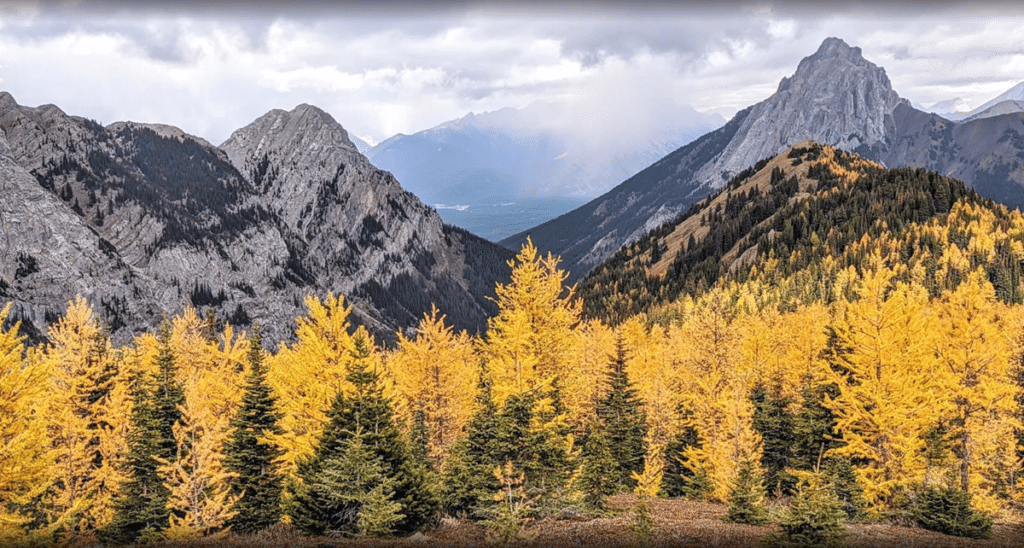
Arethusa Cirque
| Location | Distance: 4.5 kms (2.8 miles) | Route Type: Loop |
| Elevation: 324 metres (1063 feet) | Difficulty: Moderate |
The trail starts at the far left of the parking lot, where signs are scarce, so having a downloaded app from AllTrails will come in handy. You’ll ascend a narrow path beside a gorge, leading to the cirque’s summit, where the terrain can be tricky. It’s a bit challenging but manageable with care and patience.
At the peak, you’re treated to breathtaking mountain vistas in every direction. The larches will be scattered throughout the mountain sides. It’s advised to tackle this hike clockwise and consider using hiking poles for stability. If there’s snow, be sure to wear crampons for traction, as it can slow you down a bit.
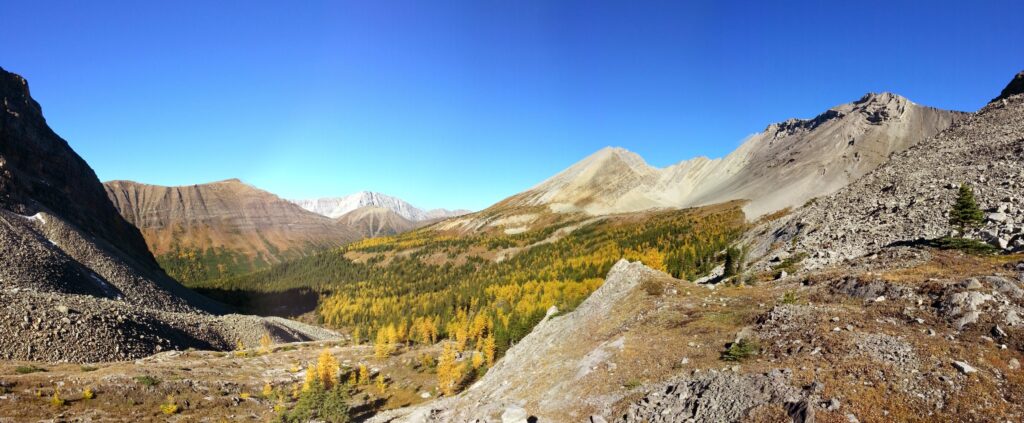
Ptarmigan Cirque
| Location | Distance: 4.5 kms (2.8 miles) | Route Type: Loop |
| Elevation: 214 metres (702 feet) | Difficulty: Easy |
Ptarmigan Cirque offers a scenic loop hike that begins on a broad path and crosses the highway and transitions into steep switchbacks through the forest— a challenging section for novice hikers. The trail gains elevation, unveiling rocky terrain with stunning views, meadows, and vibrant golden larches. The narrow ridge completes the loop before the descent.
Remember to pack extra layers for the windy, chilly summit. Due to the fragile alpine environment, staying on the trail is essential for conservation. Surprisingly, even in September, snow can be encountered, highlighting the elevation and mountainous setting. Check the forecast and prepare accordingly for potential winter hiking.
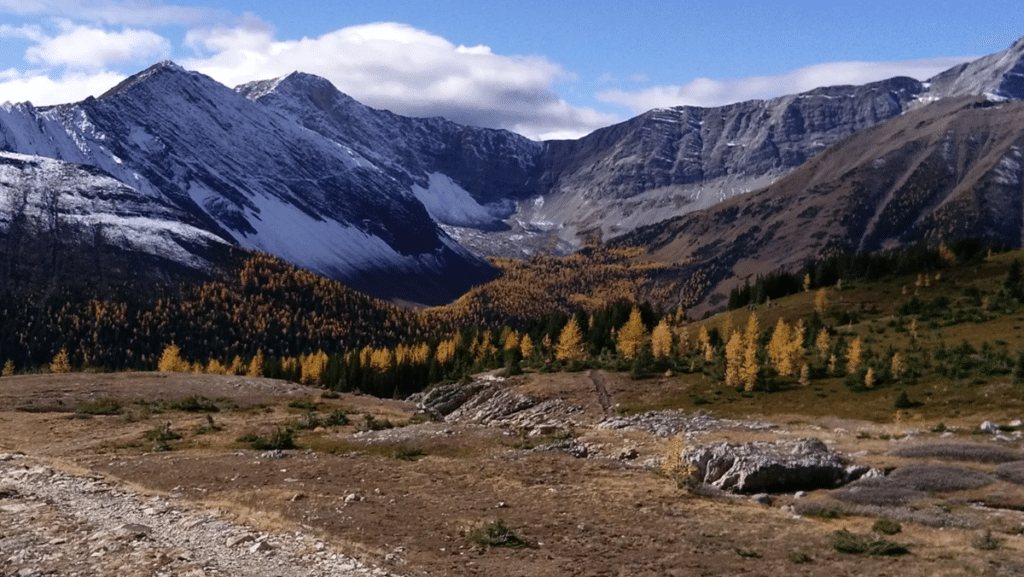
Elephant Rocks via Chester Lake
| Location | Distance: 9.3 kms (5.8 miles) | Route Type: Out & Back |
| Elevation: 419 metres (1375 feet) | Difficulty: Moderate |
This hike is located off Highway 762, the Smith Dorrien Highway, just off of Highway 40. The parking lot fills up quickly, so arriving early is advisable. The trail starts with a gradual climb through the forest, becoming steeper until it levels out around 2.6 kilometers, revealing stunning mountain vistas and a meadow.
Passing through the forest again briefly, it opens up at Chester Lake, offering breathtaking views of larch trees against the mountains during the larch season.
Take the trail up to Elephant Rocks for lunch and panoramic views of the golden larches. Return the way you came, sharing the trail with others heading to the lake. This was one of my favorite larch hikes in Kananaskis!
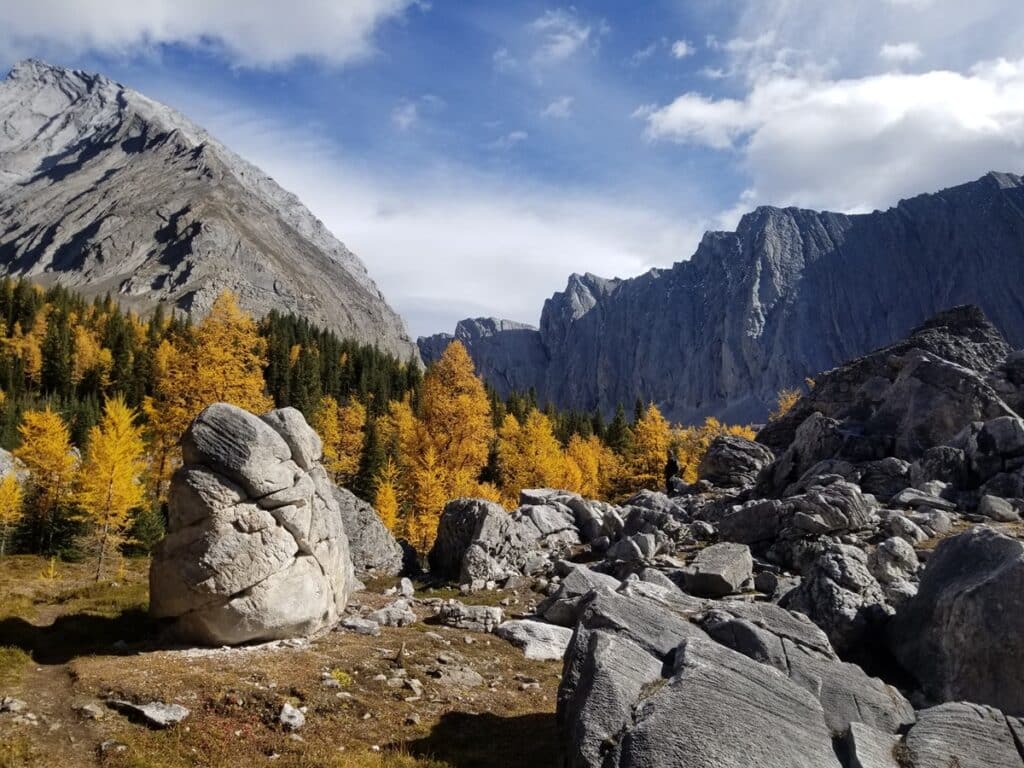
Banff National Park is another area beside Kananaskis, that you can find larch trees at higher elevations. These hikes are accessed off Highway 1, West of Banff. Note that the parking lots for both of these hikes are seasonally closed to personal vehicles and require purchasing passes if you want to park in those lots.
Larch Valley
| Location | Distance: 9.2 kms (5.7 miles) | Route Type: Out & Back |
| Elevation: 564 metres (1850 feet) | Difficulty: Moderate |
If you are looking for one of the best places to visit in Canada, look no further than Larch Valley Trail. Located near Lake Louise in Alberta, the hiking trail is about 9.2 km, which takes around 3.25 hours to finish. It is located at an elevation of 2444 m above sea level, and it has some of the most rewarding panoramic views of the surrounding forest, mountains and Moraine Lake.
The larch trees are vibrant and offer shade for you to rest. You can see snow covering the mountains. The view of Banff National Park is quite rewarding after you reach the top. Along the way, you should consider its richness in flora and fauna. You never know, you might spot bunnies and pine martens.
The trail is considered challenging where it covers 2.5 kilometers through the stunning forest. It starts at a flat lakeshore path and then branches to the right toward the forest. Halfway to the hike, you will encounter a beautiful view of Moraine Lake, which is a great place to rest and relax. You might also consider having a picnic at the location. I am sure it would take your breath away.
Once you continue through the golden larch forest, you will also have a mesmerizing view of Eiffel Lake, so bring your camera to take pictures of the beautiful outdoors. You might also want to come early to avoid the tourist crowds. It is a good idea to bring mosquito repellent with you because it is filled with many.
To reach the trailhead for Larch Valley, the park provides a shuttle service from Banff or Lake Louise which must be booked in advance, so planning is key.
Recommended by Ossama Alnuwaiser, Awesome Traveler
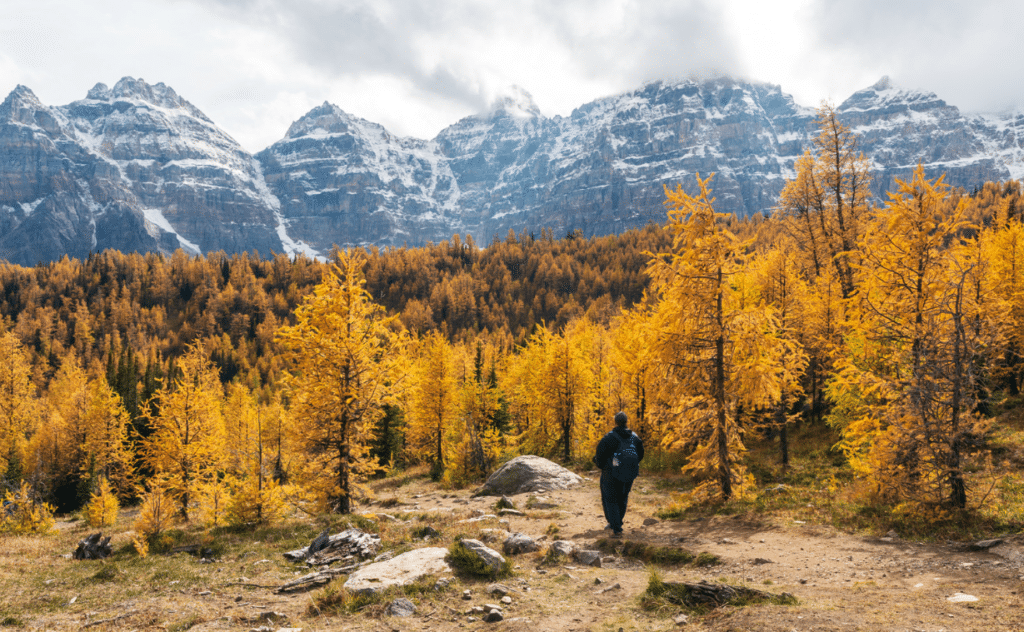
Lake O’Hara Alpine Circuit
| Location | Distance: 11.1 kms (6.9 miles) | Route Type: Loop |
| Elevation: 882 metres (2894 feet) | Difficulty: Hard |
Lake O’Hara is located in Yoho National Park, British Columbia, Canada, right at the border with Alberta. The lake is a hidden gem in the Canadian Rockies, and its precious wilderness and unique beauty are preserved for only a limited number of visitors each year. The access to Lake O’Hara is managed through Parks Canada shuttle bus reservations online. A draw takes place annually during March, for visits between June and October, with an option to choose a daily visit or camping. The lucky winners will get to experience pure nature in one of the most beautiful places in the Canadian Rockies, surrounded by incredibly high mountains, many larch trees, lakes, and wildlife.
There are several trails around Lake O’Hara, and Alpine Circuit would be the ultimate choice to experience the full beauty of the area. The trail is incomparably beautiful with the most breathtaking vistas all around. This is a long and difficult hike with a great elevation gain, along with some exposed areas and some scrambling to do along the way. In addition, the fact that Lake O’Hara is already sitting at a high altitude of 2000 meters to begin with, makes the route even more challenging.
Timing your Lake O’Hara visit with the larch season during September will add a great bonus to an already picturesque scenery. During this time, the yellowing golden pine needles will begin to scatter the area, creating a rare stunning sight, lasting just a few weeks. Lake O’Hara’s high elevation provides the perfect environment for larch trees to grow in high numbers, making it a great and exclusive place to experience that rare natural wonder.
As Recommended by Alina Kaplanova, The Luxury Travelers
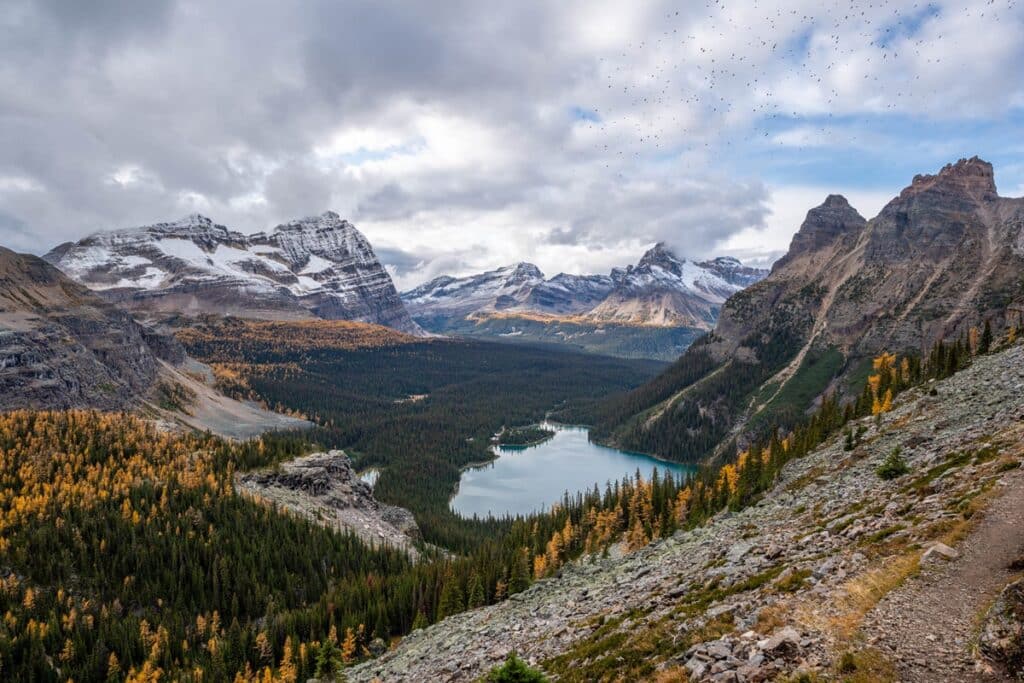
Rockbound Lake
| Location | Distance: 16 kms (10 miles) | Route Type: Out & Back |
| Elevation: 1000 metres (3000 feet) | Difficulty: Hard |
If you’re looking for off-the-beaten-path hikes for larches in the Banff area, the Rckbound Lake hike is a perfect one to find some peace and quiet surrounded by gold. The Rockbound Lake hike is around 10 miles round trip, but you can stop before the end for A+ views, making it closer to an 8-mile hike. Over that span, you can expect to gain around 3,000 feet (1,000 meters).
For most of the trail, you’ll be trekking upwards in a forest without substantial views. Then, all of a sudden, you’ll level out, and your larches will come into view. I sadly missed their peak by a few days, so a lot of the needles were on the ground. But the potential is there for a magical larch display. There are a couple of points that you need to see.
The first is when you reach Tower Lake. Here, you’ll have gorgeous views of Castle Mountain Rising high above you. The second place is half a mile further up the trail. You’ll come to an overlook with Tower Lake below and the stunning peaks of the Canadian Rockies on the horizon. This is the prized shot and one you’ll ooh and ahh at for a while.
If you’re chasing larches in Banff, I highly recommend adding this trail to your list. You’ll love the views – especially without throngs of people in the way.
As Recommended by Alec Sills-Trausch, Explore With Alec
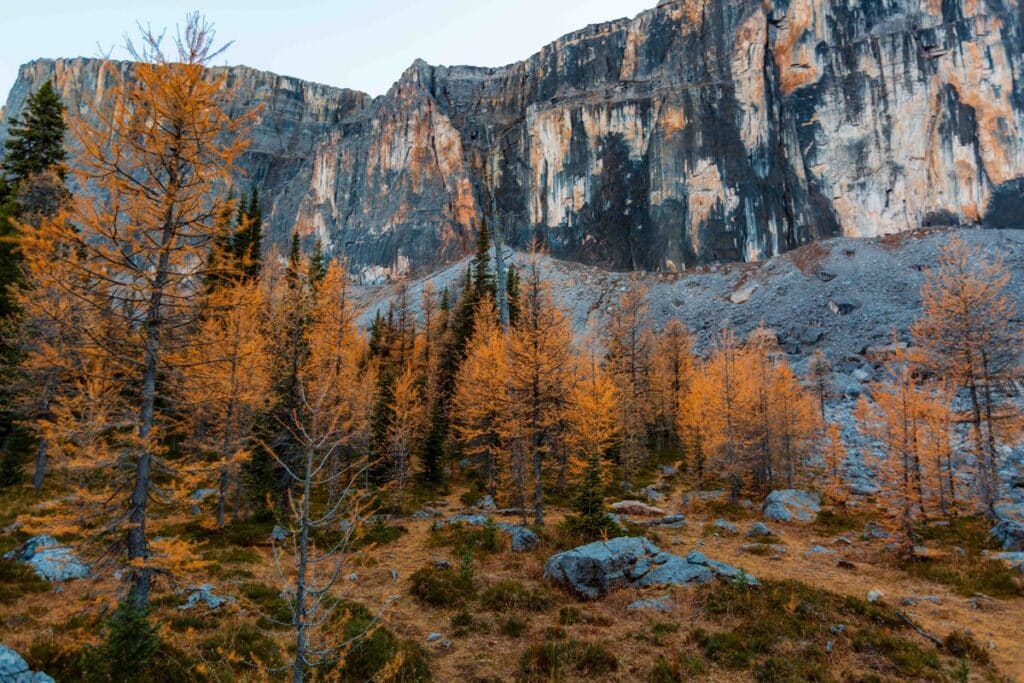
Where Else Can You See Larches in North America?
In North America, several national parks offer spectacular views of larches turning golden in September, providing ideal hiking opportunities including Jasper National Park in Alberta, Mount Assiniboine Provincial Park in British Columbia, Glacier National Park in Montana and North Cascades National Park, Washington.
These parks offer a combination of accessibility and natural beauty, making them excellent choices for those wishing to experience the golden larches in September in other areas.
Extending Your Visit To The Canadian Rockies
For easy access to Larch Valley or Lake O’Hara, consider spending the weekend in Banff. There are many things to do in Banff to complement your hiking. Explore the charming town, dine at local eateries, and immerse yourself in the beauty of Banff. Spending the night at one of the many accommodation options in Banff ensures an early start to beat the crowds.
You might choose to base yourself in Canmore for access to hikes along Highway 40. Enjoy a day exploring the town’s shops, cafes, and galleries before retreating to your accommodations in Canmore for a restful night’s sleep. Planning this provides convenient access to various larch hiking trails in either direction.
If you are in Calgary and are looking for other hikes to do, there are many other hikes in Kananaskis that can be accessed all year round. Though the hikes off Highway 546 and Highway 22 will not showcase larches, you will get to see the beautiful autumn colors of the Canadian Rockies.
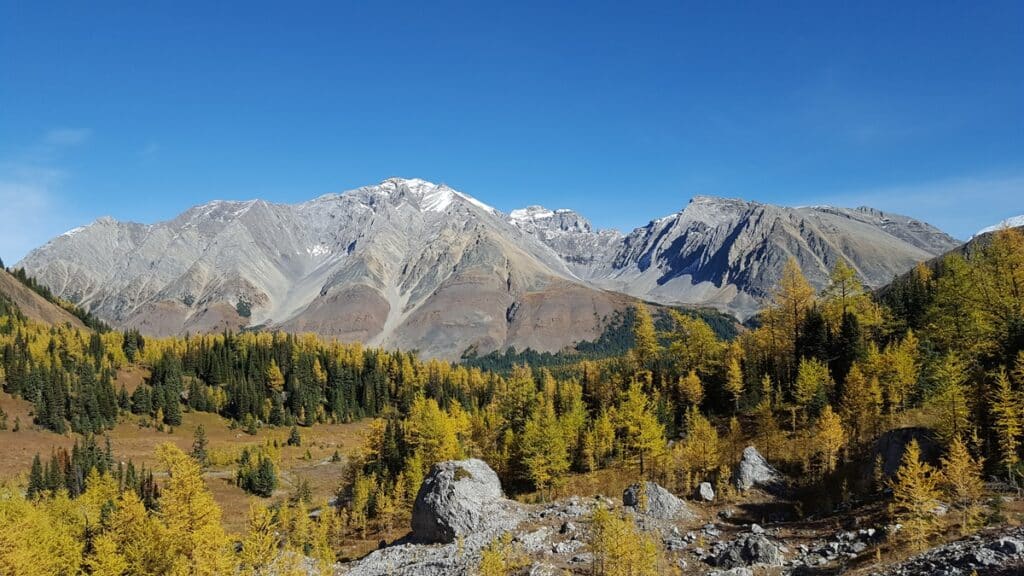
Be Bear Aware
While enjoying larch hikes in Kananaskis, it’s essential to ensure you are prepared with proper bear safety tips. This area is very popular for grizzly and brown bears, especially during this time when they are bulking up for their upcoming hibernation. Carry bear spray, make noise while hiking, and stay alert for signs of bear activity. Respect wildlife by keeping a safe distance and following park regulations.
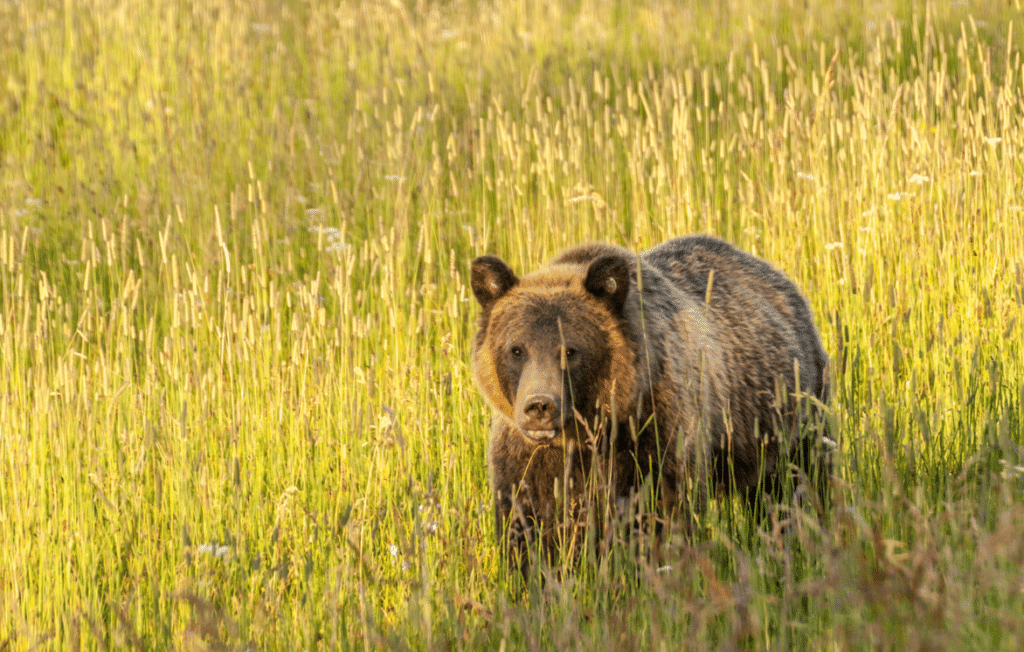
Larch Hike Tips
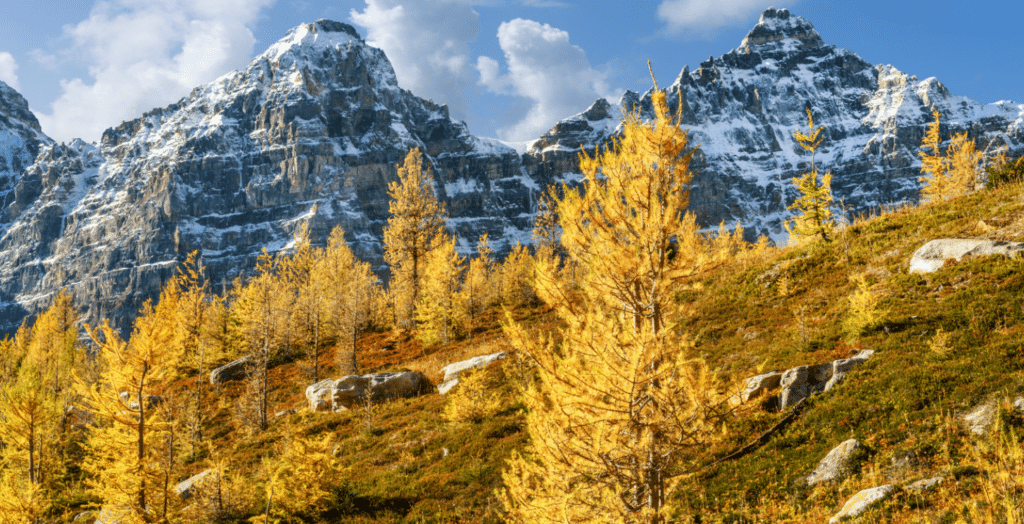
Final Thoughts
I absolutely love doing larch hikes in Kananaskis in September. It is one of my favorite times of year to hike. The beauty of autumn is inspiring as you explore these iconic hiking trails, and take in the breathtaking scenery of the Canadian Rockies. Don’t miss your chance to experience it firsthand.
If you enjoyed my post, follow me on social media or subscribe to my newsletter below, so you can stay connected on future posts, trips, tips and more.


